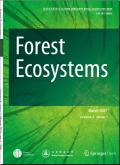Trends in alpha diversity, community composition, and network complexity of rare, intermediate, and abundant bacterial taxa along a latitudinal gradient and their impact on ecosystem multifunctionality
IF 4.4
1区 农林科学
Q1 FORESTRY
引用次数: 0
Abstract
Soil microbial communities are key factors in maintaining ecosystem multifunctionality (EMF). However, the distribution patterns of bacterial diversity and how the different bacterial taxa and their diversity dimensions affect EMF remain largely unknown. Here, we investigated variation in three measures of diversity (alpha diversity, community composition and network complexity) among rare, intermediate, and abundant taxa across a latitudinal gradient spanning five forest plots in Yunnan Province, China and examined their contributions on EMF. We aimed to characterize the diversity distributions of bacterial groups across latitudes and to assess the differences in the mechanisms underlying their contributions to EMF. We found that multifaceted diversity (i.e., diversity assessed by the three different metrics) of rare, intermediate, and abundant bacteria generally decreased with increasing latitude. More importantly, we found that rare bacterial taxa tended to be more diverse, but they contributed less to EMF than intermediate or abundant bacteria. Among the three dimensions of diversity we assessed, only community composition significantly affected EMF across all locations, while alpha diversity had a negative effect, and network complexity showed no significant impact. Our study further emphasizes the importance of intermediate and abundant bacterial taxa as well as community composition to EMF and provides a theoretical basis for investigating the mechanisms by which belowground microorganisms drive EMF along a latitudinal gradient.
稀有、中等和丰富细菌类群α多样性、群落组成和网络复杂性沿纬度梯度的变化趋势及其对生态系统多功能性的影响
土壤微生物群落是维持生态系统多功能性的关键因素。然而,细菌多样性的分布模式以及不同细菌分类群及其多样性维度如何影响EMF仍然是未知的。本文以云南省5个样地为研究对象,研究了稀有、中等和丰富类群的α多样性、群落组成和网络复杂性的变化,并分析了它们对EMF的影响。我们的目的是表征跨纬度细菌群的多样性分布,并评估它们对电磁场的贡献机制的差异。我们发现,稀有、中等和丰富细菌的多方面多样性(即通过三种不同指标评估的多样性)通常随着纬度的增加而降低。更重要的是,我们发现稀有细菌类群倾向于更加多样化,但它们对EMF的贡献小于中等或丰富的细菌。在我们评估的多样性的三个维度中,只有群落组成显著影响所有地点的EMF,而alpha多样性具有负向影响,网络复杂性没有显著影响。本研究进一步强调了中间和丰富的细菌类群及其群落组成对电磁场的重要性,并为研究地下微生物沿纬度梯度驱动电磁场的机制提供了理论基础。
本文章由计算机程序翻译,如有差异,请以英文原文为准。
求助全文
约1分钟内获得全文
求助全文
来源期刊

Forest Ecosystems
Environmental Science-Nature and Landscape Conservation
CiteScore
7.10
自引率
4.90%
发文量
1115
审稿时长
22 days
期刊介绍:
Forest Ecosystems is an open access, peer-reviewed journal publishing scientific communications from any discipline that can provide interesting contributions about the structure and dynamics of "natural" and "domesticated" forest ecosystems, and their services to people. The journal welcomes innovative science as well as application oriented work that will enhance understanding of woody plant communities. Very specific studies are welcome if they are part of a thematic series that provides some holistic perspective that is of general interest.
 求助内容:
求助内容: 应助结果提醒方式:
应助结果提醒方式:


